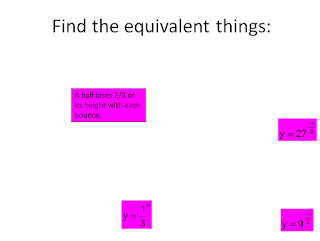In our environment, the closest thing to a station is what we call a breakout room, or bor for short. They are really just other websites, of course, that are somehow attached to the main classroom. Here is how they usually look from the dashboard:
Usually, I put students into whichever room I want by dragging and dropping their name into it, much like moving a file into a folder, and in fact it ends up looking that way too (pretend I'm a student):
But I can create as many bors as I want, and call them what I want, and make them any colour I want, so today, here is how my stations looked:
Why did I set them up this way? Because this was the activity:
The task was to shade equivalent boxes in matching colours, using the properties of exponents, and the exponential situations we've studied so far, including rational exponents, negative exponents, and the property (a^n)^m = a^(nm).
Here's how it went down, along with how it would look in a brick and mortar situation, in case it's hard to get your head around what the heck I'm talking about:
Step 1: Simulate easy movement:
First I gave them all moderator status so THEY could move themselves into and out of any bor they wanted. This way they all get to go to each room at their own pace, plus I found it was a nice break from me picking who is going to work with whom. Also it makes it feel more like they're moving around in a classroom station situation. We first practised that a bit, so they could get used to the controls.
Brick and mortar equivalence: Kids can usually move around in a classroom.
Step 2: Clear goals at stations
Upon entering a bor, they all saw the same slide, which was the one above. Then, if they were in the turquoise bor, they'd colour in (using the virtual highlighter pen) all the things equivalent to y = (1/2)^x, if they were in the yellow bor, they'd colour all the things equivalent to y = 3^x, etc. Students can see what bor they're in, so again, it's all as obvious as if they were in a brick and mortar classroom.
Brick and Mortar equivalence to this: Having 4 big tables, each with a giant place-mat like the above, preferably with a covering that makes it easy to erase, with each table equipped with highlighter pens in only one of the four colours, so there's a bunch of turquoise pens at one table, and a bunch of pink pens at another etc. It's important that the highlighter pens be erasable though, and I don't know if such a thing exists. So also you'd need erasers.
Step 3: Keep things moving
After a few minutes, I said "Change rooms!" and watched their names jump around. I had already told them that if they agreed with the colouring that had already been done, leave it there, and see if there were any other things that should be coloured. If they disagreed with what was already coloured, they could change it. The idea was that this would filter out the easy egs from the harder ones, by a loosely formed consensus.
Brick and mortar equivalence: Saying change stations, whereupon students move to another table. They can change what's already coloured and add as needed. I'd probably have to make sure the right coloured pens would stay at the right table!
Step 4: Keep things moving and varied
Repeat step 3 twice, so that everyone has had a chance to go to each station.
Step 5: Process the math
I took snapshots of each of the final bor screens as everyone moved them selves back to the main classroom.
Brick and mortar: Telling everyone to go back to wherever they usually sit while I gather the place mats.
Step 5: I displayed each snapshot, we discussed, I showed the answers, and we discussed some more. (Brick & Mortar I'd do the same.) Here are a few of the actual ones, compared to the answer slides:
 |
| The turquoise were all correctly coloured |
 |
| The greens were mostly correct |
 |
| Missing a few pinks and one incorrect |
 |
| Add caption |
 |
| And missing a few yellows |
Here's where my evil plan started really playing out:
- Each colour had some really obvious ones that were not in dispute, like 3^(-x) and (1/3)^x, so we didn't have to spend much time at all on those.
- Each colour also had some that weren't so obvious, like why is 27^(-x/3) the same as (1/3)^x? Also the one about why losing 2/3 gave a base of 1/3. This was a chance to add a layer to their understanding of exponential properties. I asked for volunteers to explain these.
- Each colour had something that I anticipated no one would colour, and bingo, I was right! These examples involved e, and for most this was the first time they'd seen it. So this was a nice way to introduce it.
I usually try to think of what I'd do to improve, but all I can think of is additional examples to add. Since there was no dispute over the turquoise, that could use something in it to uncover a gap in understanding. Otherwise, this went well, and it didn't take a lot of set up, since there was only one slide for all the rooms. Also, I didn't have to chase after any actual pens!







Wizard! :)
ReplyDeleteWingardium Leviosa :-)
Delete